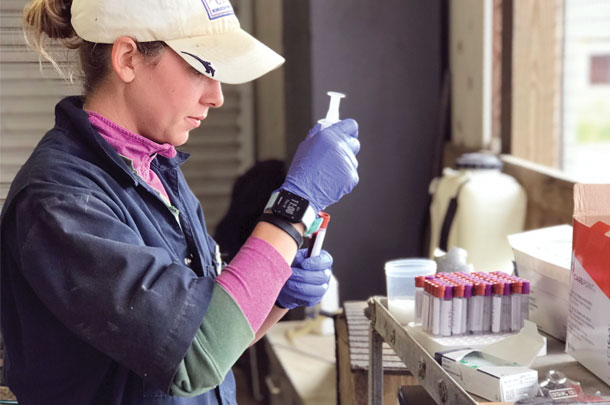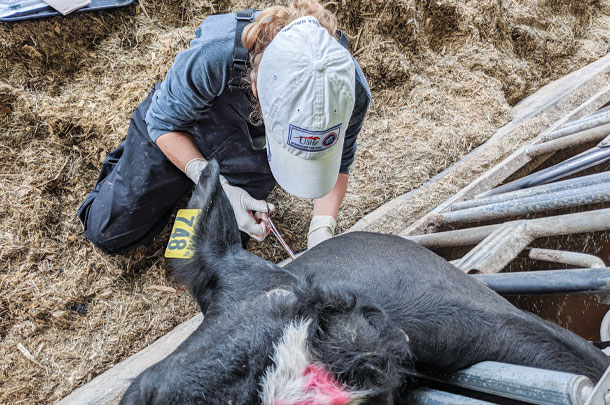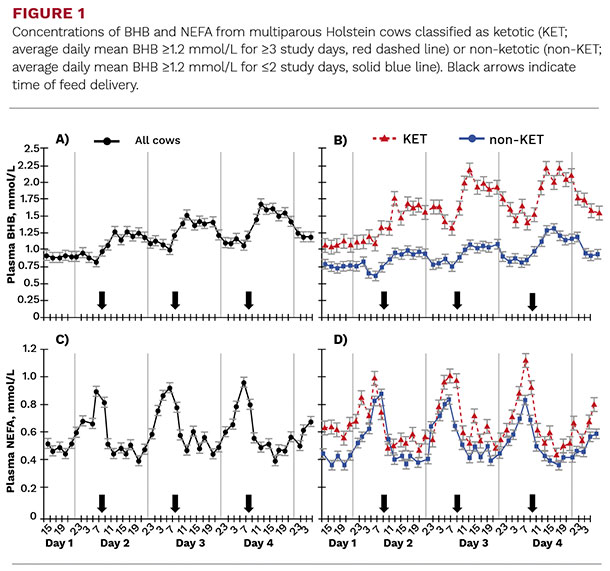To maintain normal body functions and milk production during energy deficit, cows mobilize fat stores. When fat is broken down, non-esterified fatty acids (NEFA) are released into the blood, and are transported to the liver for energy production. However, when NEFA are present in the liver in excessive amounts, they are instead converted to ketone bodies and re-exported into circulation. β-hydroxybutyrate (BHB) is one of the primary ketone bodies produced by the dairy cow and considered representative of total body ketone status.

Slight increases in blood NEFA and BHB are part of the normal adaptation to lactation, offering alternative fuel sources to the cow for the maintenance of milk production. However, excessively elevated concentrations of NEFA and BHB are associated with increased risk for development of other negative health disorders, such as displaced abomasum and metritis, as well as decreased milk production and reduced reproductive success.
Ketosis, the excessive elevation of blood BHB, not only puts the cow at increased risk for developing other diseases but is also a burden to producers, costing approximately $289 per case. Several handheld meters allow for accurate cowside quantification of BHB; however, identifying individual cows with ketosis is a laborious task. Similarly, the only way to accurately quantify blood NEFA is through laboratory analysis due to the absence of an economical, on-farm test.
Concentrations of blood NEFA and BHB are also known to fluctuate throughout the day. During the overnight hours when intake is generally low, NEFA rises. Alternatively, BHB falls throughout the night and steadily rises following feed delivery. Cells lining the rumen can produce BHB from volatile fatty acids generated from rumen fermentation, explaining the increase in BHB following feeding. Because little is known about how ketosis affects diurnal patterns of BHB and NEFA, we conducted a study to analyze the daily fluctuations in NEFA and BHB, and if they were affected by ketosis.

We collected blood samples every two hours for five consecutive days from 28 multiparous Holstein cows that were between three and nine days in milk. Cows were housed in a tiestall facility and offered free-choice access to water and a TMR that was delivered once a day at 9:00 AM. Blood samples were analyzed for BHB and NEFA and cows were classified into ketosis groups based on their average daily BHB concentration. If a cow’s average daily BHB was ≥1.2 mmol/L for ≥3 study days, she was assigned to the ketosis group (n=13). Alternatively, if her average daily BHB was ≥1.2 mmol/L for ≤2 study days, she was assigned to the non-ketosis group (n=15).
We saw the lowest concentrations of BHB just prior to feeding, at 7:00 AM, with a steady rise following feed delivery (Figure 1A). Not surprisingly, BHB was higher in the ketosis cows than the non-ketosis cows (Figure 1B). Unlike BHB however, we saw a peak in NEFA just prior to feeding, at 7:00 AM, with concentrations falling quickly after feed delivery (Figure 1C). The ketosis cows had greater concentrations of NEFA than the non-ketosis cows (Figure 1D).

To understand the effect of ketosis on the daily fluctuations of BHB and NEFA, we calculated the difference between the daily maximum and minimum concentrations for each metabolite by ketosis group. The ketosis cows experienced a nearly two-fold greater difference between daily maximum and minimum BHB concentration compared to the non-ketosis cows. Interestingly, the difference between daily maximum and minimum concentrations of NEFA were relatively similar for both the ketosis and non-ketosis cows.
Our study shows blood NEFA and BHB have consistent daily patterns. Time relative to feeding should be considered when analyzing blood for energy metabolites, specifically NEFA and BHB, as concentrations vary significantly throughout the day. Additionally, blood sampling for ketosis diagnosis should be performed at a consistent time of day to more accurately capture the energy status of early lactation cows. ![]()
PHOTOS: Blood NEFA and BHB have consistent daily patterns. Time relative to feeding should be considered when analyzing blood for energy metabolites, specifically NEFA and BHB, as concentrations vary significantly throughout the day. Additionally, blood sampling for ketosis diagnosis should be performed at a consistent time of day to more accurately capture the energy status of early lactation cows.
Claira Seely is a PhD Student with the Department of Population Medicine and Diagnostic Sciences at Cornell University College of Veterinary Medicine. Email Claira Seely. Kathryn Bach is a Postdoctoral Associate with the Department of Population Medicine and Diagnostic Sciences at Cornell University College of Veterinary Medicine. Email Kathryn Bach. Dave Barbano is a Professor with the Department of Food Science at the College of Agriculture and Life Sciences, Cornell University. Email Dave Barbano. Jessica McArt is an Assistant Professor with the Ambulatory and Production Medicine Clinic at Cornell University College of Veterinary Medicine. Email Jessica McArt.
This article appeared in PRO-DAIRY’s The Manager in July 2020. To learn more about Cornell CALS PRO-DAIRY program, visit PRO-DAIRY Cornell CALS.






